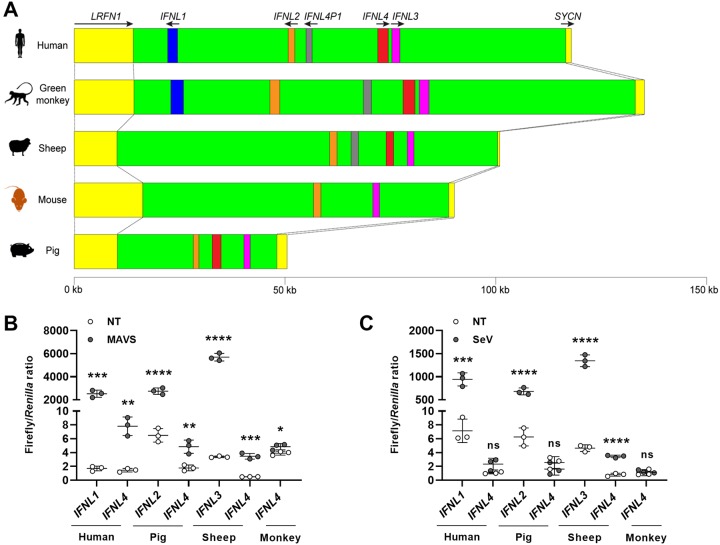FIG 4.
The weak functionality of the IFNL4 promoter is evolutionarily conserved among mammals. (A) Overview of the type III IFN loci in humans, African green monkeys, sheep, mice, and pigs. The type III IFN genes illustrated by different colors share a synteny in mammals and are flanked on each side by the leucine-rich repeat and fibronectin type III domain containing 1 (LRFN1) and syncollin (SYCN) genes. Black arrows indicate the direction of transcription for each gene. (B) HEK293T cells were cotransfected with a pGL3.1 plasmid containing IFNL4 or the IFNL1, IFNL2, or IFNL3 promoter from humans, African green monkeys, pigs, or sheep; a plasmid constitutively expressing the Renilla luciferase gene; and a plasmid constitutively expressing MAVS. At 24 h posttransfection, firefly/Renilla luciferase activity was quantified. One representative out of two independent experiments is shown, each with biological triplicates. The data are presented as a scatter plot with mean ± SD (n = 3). (C) HEK293T cells were cotransfected with a pGL3.1 plasmid containing IFNL4 or the IFNL1, IFNL2, or IFNL3 promoter from humans, African green monkeys, pigs, and sheep and a plasmid constitutively expressing the Renilla luciferase gene. At 24 h posttransfection, the cells were infected with SeV for another 24 h before quantification of firefly/Renilla luciferase activity. One representative out of two independent experiments is shown, each with biological triplicates. The data are presented as a scatter plot with mean ± SD (n = 3). Statistical significance was determined using an unpaired t test. ****, P < 0.0001; ***, 0.0001 < P < 0.001; **, 0.001 < P < 0.01; *, 0.01 < P < 0.05; ns, P ≥ 0.05.

